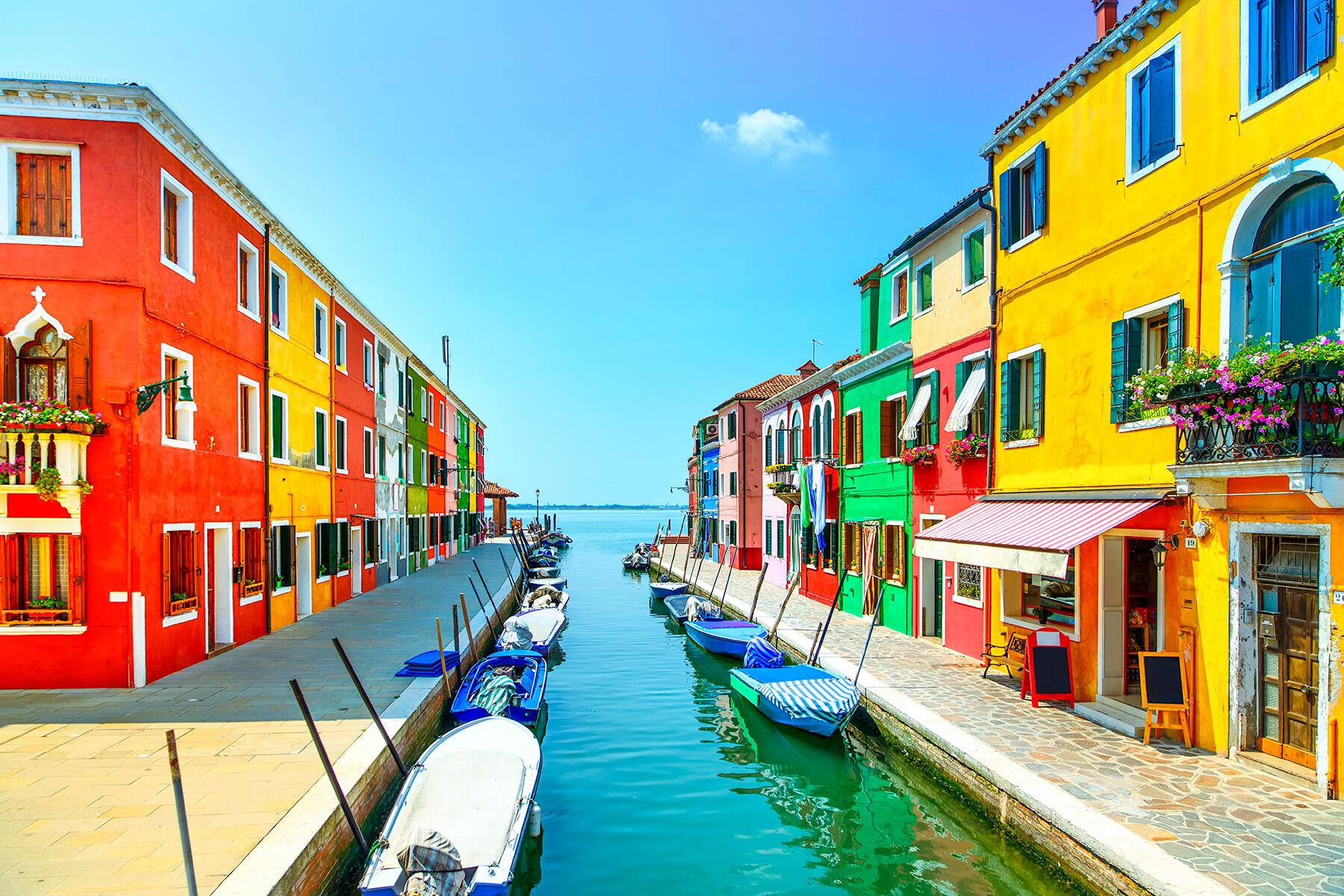There is so much more to Venice than Venice.
Venice is commonly misconceived as a single island. In reality, the main island of Venice itself is a conglomeration of some 118 landmasses woven through with canals, while the surrounding lagoon is peppered with dozens of other islands, both inhabited and uninhabited. Taking a Vaporetto (waterbus) trip to at least one other island will help you better understand Venice’s history and geography. It also immerses you in lagoon life and initiates a pace reset after the frenetic compulsion to see and do in the historic center.
Related: We Answer the 13 Most Frequently Asked Questions About Venice
Eat in a Waterside Restaurant on the Giudecca
WHERE: Giudecca
The Giudecca is a long, thin strip of land separated from Venice proper by the wide homonymous canal to the south. The island is considered part of Venice’s Dorsoduro neighborhood but embodies a different, quieter character. In summer, take a 10-minute Vaporetto ride over to enjoy the near-constant breeze playing through its undisturbed residential streets. This is the place to nab a waterside table and indulge in a reasonably-priced seafood lunch overlooking the glinting canal with Venice like a stage-set backdrop.
Climb the Bell Tower of San Giorgio Maggiore
WHERE: San Giorgio Maggiore
St. Mark’s iconic bell tower is usually preceded by snaking queues as visitors seek a bird’s eye view of the canal city. But the bell tower of San Giorgio Maggiore, a shimmering white church by neo-classical master Andrea Palladio, offers a more expansive view. From there, you see Venice in its lagoon context as well as the turquoise sweep of the Giudecca canal, the resplendent Baroque Salute church, and you see the five Eastern-inspired domes of St. Mark’s Basilica peeping up behind the ice-cream pink Doge’s Palace.
Recommended Fodor’s Video
Watch a Glassmaking Demonstration on Murano
WHERE: Murano
Safety concerns over accidental conflagrations forced authorities to relocate Venice’s glassworks to the island of Murano, where they have fired molten globules into elegant, ethereal designs for nearly 800 years. Several glass factories hold demonstrations, from the long-standing Simone Cenedese to changemakers Chiara Taiariol and Mariana Oliboni at el Cocal, the first female-run factory in the male-dominated industry.
Marvel at a Mosaic Floor on Murano
WHERE: Murano
Murano’s Basilica of Santa Maria and San Donato is a behemoth of medieval religious architecture. The canal-side exterior of the apse is decorated with a rhythmic series of arches, while the main façade is imposing in its simplicity. Inside, you find a mosaic marvel beneath your feet. The multicolored tiles depict a compendium of complex symbols representing eternity, immortality, and other cerebral spiritual concepts.
Find the Beadmakers of Murano
WHERE: Murano
Glassblowing is usually thought of as large-scale and theatrical. But there’s another side to the profession where women dominate. Called lampwork, it sees glass heated and manipulated on a small scale using blow torches. In tiny workshops hidden along Murano’s narrow streets, artists like Alessia Fuga create intricate, highly decorative beads that are made into statement jewelry.
See the Oldest Mosaics in the Lagoon on Torcello
WHERE: Torcello
To get to the island of Torcello, you journey around one hour through the lagoon and several centuries back in time. The island was the first area of the lagoon to be inhabited when mainland residents fled from invading barbarians in the 5th and 6th centuries. The ancient Santa Maria Assunta cathedral contains the oldest mosaics in the Venice area, which still shimmer gracefully and golden on the walls.
Go Birdwatching on Torcello
WHERE: Torcello
Torcello is an island of wild, untamed nature away from the cathedral and scattering of houses. Birdwatching enthusiasts can book an experience with fisherman and nature expert Andrea Rossi at his 360-degree observatory. The northern lagoon has long been a crossroads for migratory species, and today, you can spot falcons, pheasants, herons, and cormorants.
Sleep on a Private Island on Isola Santa Cristina
WHERE: Isola Santa Cristina
Far north in the lagoon’s brackish water lies a dot of land—Isola Santa Cristina. The eco-sustainable island is rich with orchards, vineyards, natural fish farms, and cypress-lined walks where wild peacocks roam. One eight-bed property on Isola Santa Cristina is available to rent in its entirety. From its rooftop terrace—known as an Altana in Venice—you can gaze across the unruffled lagoon all the way to the snow-dusted Dolomite mountains.
Visit the Lace Museum on Burano
WHERE: Burano
Instagrammers make a beeline for Burano to snapshot its candy-colored houses, but there’s much more to the island. The small community has been hand-crafting exquisite lace for generations. Head to the Museo di Merletto—the lace museum—which chronicles the island’s craft traditions that originated in the 16th century.
Drink Gold Wine on Mazzorbo
WHERE: Mazzorbo
The Vaporetto to Burano stops first at Mazzorbo, an island connected to Burano via a footbridge. Mazzorbo rarely makes it into the guidebooks, but make a stop at its walled garden and vineyard, where an ancient grape has been rescued from near extinction. The Dorona grape—the name referring to its golden hue—once graced the tables of the doges, the leaders of the Venetian republic. Floods in 1966 nearly wiped the variety out, but islanders managed to nurse a few vines back to life, and winemaker Gianluca Bisol began a replanting project. Now, you can try the prized wine at Venissa, paired with a Michelin-starred lagoon-based lunch.
Visit an Ancient Monastery on San Francesco Del Deserto
WHERE: San Francesco Del Deserto
Accessible only by private transport, the island of San Francesco del Deserto—named after St Francis of Assisi, who is said to have visited in 1220—is an oasis of lagoon tranquility. It is home to a 13th-century Franciscan monastery inhabited by a handful of monks who lead guided tours. After visiting the complex, spend a few peaceful moments in the cypress-shaded garden in quiet contemplation.
Peddle Through Vineyards on Sant’Erasmo
WHERE: Sant’Erasmo
The largest island in the Venetian lagoon is Sant’Erasmo, which Venetians consider the city’s countryside. The sparsely populated isle is also dubbed Venice’s vegetable garden because it grows mineral-packed produce for the Rialto market, including the famed violet artichoke—honored at a food festival each May. Rent bikes and peddle through fields, vineyards, and swathes of unspoiled nature.
Sunbathe on Pellestrina
WHERE: Pellestrina
The journey is a bit of a trek—involving a boat, bus, and bus on a boat—but Pellestrina is worth a day trip in summer. The island is a narrow strip of land that effectively forms the border between lagoon and sea. Eleven kilometers long and just 5 meters wide at some points, the island has four petite villages of brightly-colored houses, and the seaward side is a sweep of wild beaches where residents build impressive driftwood shelters for summer barbeques.
Laze on the Lido
WHERE: The Lido
The Lido has gained fame as the location of the star-studded Venice Film Festival, but it’s also the city’s beachside resort. The 11-kilometer stretch of sand is lined with stabilimenti balneari—beach clubs and restaurants—as well as grande dame hotels in lavish art deco and Moorish-inspired styles. At the furthest end from Venice is a nature reserve with some of the best-preserved dune habitats in the Adriatic Sea.
Wander Around an Island Cemetery on San Michele
WHERE: San Michele
In the 19th century, a Napoleonic decree banned burials from taking place in Venice proper over sanitary concerns. Since then, the island of San Michele has become the city’s cemetery. It is surrounded by a high red brick wall over which peep cypress trees and is home to the gleaming white San Michele church from the 15th century. The island is the final resting place for Venetians but also famed foreigners, including American poet Ezra Pound, Russian-born writer Josef Brodsky, and Russian composer Igor Stravinsky.







The Lido is one of my favorite places.